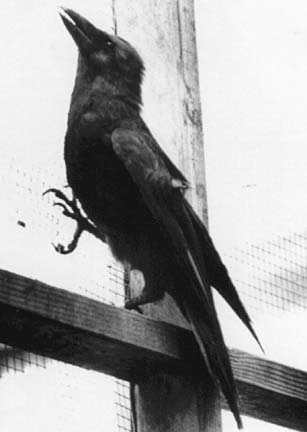
AP FILE PHOTO
The alala, like this one pictured at a breeding facility on Maui in 1990, is a medium-sized crow about 14 inches in length.
Native crow endangered
by endangered hawk
WAILUKU >> An endangered Hawaiian crow is having problems being reintroduced into the wilderness because it is falling prey to another endangered species -- the Hawaiian hawk, or io.
Biologists said the predation is one of the reasons it has decided to revise the recovery plan for the alala and keep the native crow temporarily in captive bird facilities on the Big Island and Maui.
Attempts to reintroduce captive alala into the wilderness in the last 10 years in west Hawaii have suffered setbacks. Twenty-one of the birds have died and none of the wild population has been seen since June 2003, said Jeff Burgett, a biologist with the U.S. Fish and Wildlife Service.
The alala, known scientifically as Corvus hawaiiensis, is a medium-sized crow about 14 inches in length that was once common in ohia and koa forests on the western and southern portions of the Big Island.
Before the arrival of westerners in the late 1700s, the alala was highly regarded by native Hawaiians and treated as an aumakua, or family guardian, according to federal researchers.
Burgett said that of the 21 dead alala, seven were killed by the io, eight disappeared due to unknown causes, and others died because of disease, infection or predation from mammals, such as the mongoose.
Burgett said scientists have found that young alala released from captivity had a hard time reintegrating into a wild flock.
"They weren't readily accepted," he said.
Because they weren't familiar with living in the wilderness, many of the released alala fell prey to the io, whose numbers have been increasing, Burgett said.
The latest estimate has the number of io at about 1,400 on the Big Island, he said.
Burgett said because the density of foliage in wilderness areas on the Big Island has decreased, the alala also has less cover to hide itself.
Scientists have recaptured six introduced alala that were in the wilderness and returned them to captive breeding facilities.
Officials said 30 alala are being raised at bird conservation facilities in Volcano on the Big Island.
Under a proposed recovery plan, scientist want to raise the 40 alala in captivity at least until the numbers double in the next five years.
Burgett said having one endangered species prey upon another endangered species is not unique and has happened in the past.
He said scientists are considering whether to move the alala from its native habitat on the Big Island to a habitat on Maui where there are no io.
About $900,000 a year is spent to support a captive breeding program for endangered birds on the Big Island and Maui.
Under the proposed plan, scientists would spend $11.8 million in the next five years mainly to improve the habitat in the wilderness to make survival more conducive to the alala and also expand the captive breeding facilities.
A draft of the alala recovery plan is available at the U.S. Fish and Wildlife Service Web site at http//pacificislands.fws.gov or by calling the service's Honolulu office, (808) 792-9400.
Written comments may be submitted to the Field Supervisor, Pacific Islands Fish and Wildlife Office, 300 Ala Moana Blvd., Room 3-122, Box 50088, Honolulu 96850.
